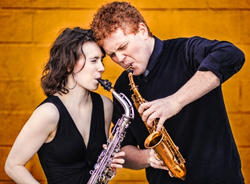by Mike Telin

The duo will perform three works with the Trinity Chamber Orchestra under the direction of Todd Wilson. The program will include Johann Joachim Quantz’s Trio in c minor (arr. Sigurd Raschèr), Erland von Koch’s Concerto Piccolo (1962), and the world premiere of Dan Knorr’s Double Concerto (2015). As always, listeners can bring their lunch or purchase one on-site for $5.
“Jake and Sarah are big proponents of new repertoire for soprano and alto sax,” composer Dan Knorr said during a recent telephone conversation. “There are not a lot of concertos for the two instruments together, so they are kind of pioneers of that. Sigurd Raschèr and his daughter Corina commissioned quite a bit of music for that combination, but it’s been absent from the next generation of composers’ output. So I’d like to think that I’m contributing to something historical.”
Knorr, who received his master’s degree in composition and music theory from the State University of New York at Fredonia in May of 2015, was very excited to take on the challenge of writing the double concerto. “This is the first piece that I’ve written outside of academia,” Knorr pointed out, “and it’s my first real concerto. I’ve written what I called a micro-concerto for English horn and five accompanying instruments, but it is nothing near the scope of this piece, which is a twenty-minute, three-movement work for soprano and alto sax with full string orchestra.”
Writing the concerto in the traditional three-movement format came at the request of Jake Swanson, although Knorr said that he has modernized the format a little. “The first movement begins with singing solo lines, then moves into a rhythmic, faster-paced section with a double fugue — I wanted to write a double fugue for the double concerto. The movement ends following a cadenza.”
Knorr described the second movement as slow and somber with long, lush, melodic passages for the strings. “The piece is dedicated to the late John Geers, a Clevelander who was a big advocate for the saxophone. I only met him a few times but he was always so supportive and such a kind gentleman, so Jake, Sarah, and I wanted to do something special in his memory. The third movement is bombastic and full of energy. It revisits themes from the first movement which lead to another cadenza that ends the piece.”
With no teachers looking over his shoulder, how does this work differ from those that he wrote as a student? “In general this piece is a lot lighter than what I’ve written in the past. Harmonically it’s a bit more tonal, although my penchant for strange dissonances is certainly present. I also think it’s a little less frantic. I really was trying to move forward in my compositional style. And since I didn’t have the pressure of having to bring it to teachers, I was able to just comfortably work on the piece.”
Although Knorr enjoyed the freedom of being on his own, he did miss having the benefit of another set of watchful eyes looking at his music. “All of the decisions that I made fell on me alone. I really asked myself if I did or did not like something. I’m always wondering if there is something I could do better, so I just had to bite the bullet and put something on the paper. The hardest part is deciding whether something is going to stay in the piece or if I should rework it into something else. And not having written even a single-instrument concerto before, with this piece I had to give the soloists enough important material to make the parts substantial for both players.”
While writing the concerto forced Knorr to step out of his comfort zone and go it alone, he did have plenty of conversations with Swanson and Marchitelli about the work. “I sent Jake and Sarah excerpts all the time, and they would make comments about what worked and what needed to be revised. They’re such nice people and are so excited about what they do, so we had a lot of fun working on the concerto together. I can’t wait to hear it for the first time with a live orchestra on Wednesday.”
When Jake Swanson and Sarah Marchitelli are not seeking out composers and commissioning new works, they are actively promoting the use of vintage saxophones. In an October 2014 interview with this publication, Swanson said, “Sarah and I both use vintage instruments from the 1930s that are modeled off the original Buescher design. They’re both Buescher Aristocrats. The soprano is from 1936 and both altos are from 1938. This style of instrument has not been produced for a very long time because saxophone makers moved in the direction of building instruments that produced sounds more suited for jazz and rock. The vintage setup is more vocal and more flexible, and the sound is darker and warmer.”
According to Swanson, a growing number of both classical and jazz players are finding an appreciation for the unique sonority that is produced by vintage instruments. “Players like Sonny Rollins and Charlie Parker both used these instruments. And yes, they’re still out there. It just takes a little bit of extra love to keep them playable, but it’s worth the effort.”
Published on ClevelandClassical.com October 5, 2015.
Click here for a printable copy of this article



